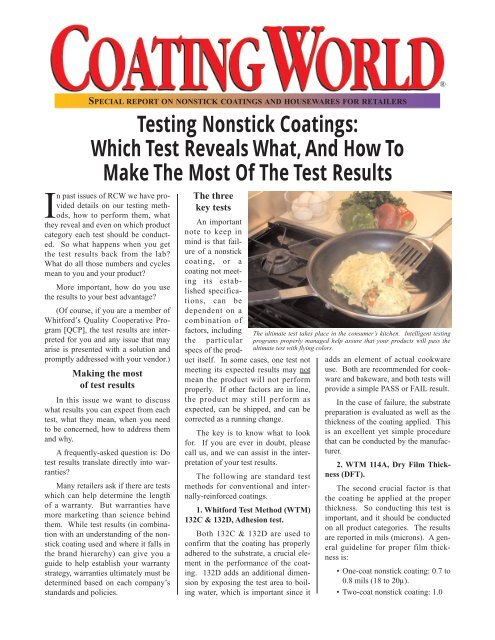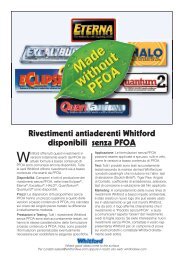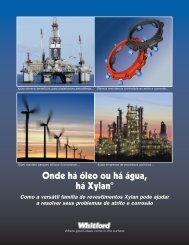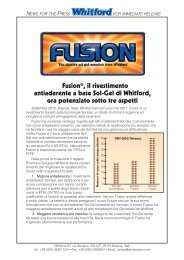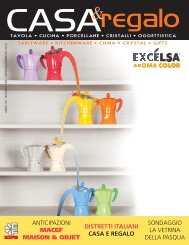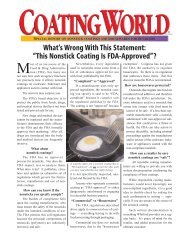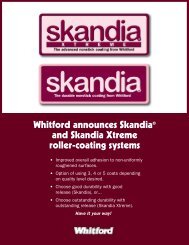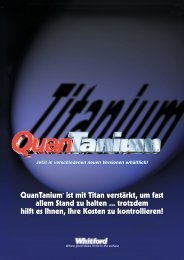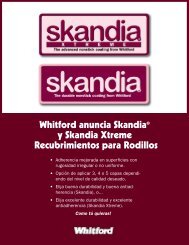Testing Nonstick Coatings: Which Test Reveals ... - Whitford Corp
Testing Nonstick Coatings: Which Test Reveals ... - Whitford Corp
Testing Nonstick Coatings: Which Test Reveals ... - Whitford Corp
- No tags were found...
You also want an ePaper? Increase the reach of your titles
YUMPU automatically turns print PDFs into web optimized ePapers that Google loves.
SPECIAL REPORT ON NONSTICK COATINGS AND HOUSEWARES FOR RETAILERS<strong><strong>Test</strong>ing</strong> <strong>Nonstick</strong> <strong>Coatings</strong>:<strong>Which</strong> <strong>Test</strong> <strong>Reveals</strong> What, And How ToMake The Most Of The <strong>Test</strong> ResultsIn past issues of RCW we have provideddetails on our testing methods,how to perform them, whatthey reveal and even on which productcategory each test should be conducted.So what happens when you getthe test results back from the lab?What do all those numbers and cyclesmean to you and your product?More important, how do you usethe results to your best advantage?(Of course, if you are a member of<strong>Whitford</strong>’s Quality Cooperative Program[QCP], the test results are interpretedfor you and any issue that mayarise is presented with a solution andpromptly addressed with your vendor.)Making the mostof test resultsIn this issue we want to discusswhat results you can expect from eachtest, what they mean, when you needto be concerned, how to address themand why.A frequently-asked question is: Dotest results translate directly into warranties?Many retailers ask if there are testswhich can help determine the lengthof a warranty. But warranties havemore marketing than science behindthem. While test results (in combinationwith an understanding of the nonstickcoating used and where it falls inthe brand hierarchy) can give you aguide to help establish your warrantystrategy, warranties ultimately must bedetermined based on each company’sstandards and policies.The threekey testsAn importantnote to keep inmind is that failureof a nonstickcoating, or acoating not meetingits establishedspecifications,can bedependent on acombination offactors, includingthe particularspecs of the productitself. In some cases, one test notmeeting its expected results may notmean the product will not performproperly. If other factors are in line,the product may still perform asexpected, can be shipped, and can becorrected as a running change.The key is to know what to lookfor. If you are ever in doubt, pleasecall us, and we can assist in the interpretationof your test results.The following are standard testmethods for conventional and internally-reinforcedcoatings.1. <strong>Whitford</strong> <strong>Test</strong> Method (WTM)132C & 132D, Adhesion test.Both 132C & 132D are used toconfirm that the coating has properlyadhered to the substrate, a crucial elementin the performance of the coating.132D adds an additional dimensionby exposing the test area to boilingwater, which is important since itThe ultimate test takes place in the consumer’s kitchen. Intelligent testingprograms properly managed help assure that your products will pass theultimate test with flying colors.®adds an element of actual cookwareuse. Both are recommended for cookwareand bakeware, and both tests willprovide a simple PASS or FAIL result.In the case of failure, the substratepreparation is evaluated as well as thethickness of the coating applied. Thisis an excellent yet simple procedurethat can be conducted by the manufacturer.2. WTM 114A, Dry Film Thickness(DFT).The second crucial factor is thatthe coating be applied at the properthickness. So conducting this test isimportant, and it should be conductedon all product categories. The resultsare reported in mils (microns). A generalguideline for proper film thicknessis:• One-coat nonstick coating: 0.7 to0.8 mils (18 to 20µ).• Two-coat nonstick coating: 1.0
to 1.2 mils (25 to 30µ).• Three-coat nonstick coating:1.2to 1.4 mils (30 to 36µ).Each <strong>Whitford</strong> brand has detailedproduct specs by formula, and shouldbe confirmed with your <strong>Whitford</strong> repprior to evaluating test results. Here isan overview of <strong>Whitford</strong>-brand DFTspecs:• Xylan ® : 0.7 to 1.2 mils (18 to30 µ).• Quantum2 ® : 0.9 to 1.2 mils 23 to30µ).• QuanTanium ® : 1.0 to 1.3 mils 25to 33µ).• Eclipse ® : 1.2 to 1.5 mils (30 to38µ).If a coating is too thin, it will wearmore quickly and shorten product life.If a coating is too thick, it may causeblisters, mud cracking, sagging, andwill be more likely to peel or chip.If results are outside the requiredspecs, they should be discussed withthe coating manufacturer promptly.3. WTM 115A: Completeness ofCure.Confirming whether the coatinghas been properly cured is the thirdand final crucial factor in testing theapplication of the coating. As wehave mentioned before, the type ofcoating systems used can vary widelydepending on the end use. <strong>Coatings</strong>used for bakeware are usually verydifferent from those used for cookware,and different tests must be usedto evaluate them. Completeness ofcure is a case in point.For cookware, the nonstick coatingsused tend to be more sophisticatedmulticoat systems. A problem withcure will usually show up in one ofthe tests used to evaluate adhesion tothe substrate or one or more layerswill pull off. This is a warning thatmore investigation must be done todetermine the cause (which is frequentlyimproper cure). It is importantto involve your coating supplier atthis stage to help resolve the problem.For bakeware, simpler coating systemsare the rule and the results willbe either PASS or FAIL with WTM115A.If a coating is improperly cured(too fast, too slow, too hot, etc.) it canresult in numerous problems, includingblisters, bubbles, pinholes and prematureproduct failure.In the case of failure, the applicationprocess must be reviewed andcorrected quickly to meet productspecifications. Note: With bakewarecoatings, this test can be performedeasily right on the production line.And a failed piece can often be salvagedsimply by recuring.Additional tests:Performance Abuse*1. WTM 135C: ReciprocatingAbrasion <strong>Test</strong> (RAT).The RAT is an abuse test used tomeasure the resistance of coatings toabrasion. The pan is placed on amachine on which a Scotch-Britepad is dragged back and forth acrossthe coating under a weighted, slidingarm. The results are reported in numberof cycles. This test can be conductedon both cookware and bakewareitems.A general guideline of RAT resultsfor <strong>Whitford</strong> brands is:Cookware• Xylan: 2,000 to 3,000 cycles.• Quantum2: Approx. 5,000cycles.• QuanTanium: 10,000 to 20,000cycles.• Eclipse: 150,000 to 300,000cycles.Bakeware• Xylan: 400 to 500 cycles.• Quantum2: 1,500 to 2,000cycles.• QuanTanium: 10,000 to 15,000cycles.• Eclipse: 150,000 to 200,000cycles.It is important to contact yourcoating manufacturer for the exactspecs for the formula you are using.If the results you receive are belowthe expected range, abrasion and wearresistance are not up to spec. Youshould discuss it with the coatingmanufacturer promptly.Interpreting Results of <strong>Whitford</strong>’s Gyrograph <strong>Test</strong>Rating Description Details10 No effect Light scratching of the surface. No breakthrough atany place in the scratch pattern.8 Slight Light scratching of the surface. Inner circle of patternshows slight cut-through to basecoat and possibly tosubstrate. Outer circle not cut through.6 Moderate Moderate scratching between inner and outer circle. Bothcut through to basecoat and possibly substrate (innerusually worse than outer circle).4 Considerable Less than 25% loss of coating between inner and outercircles (estimate and record amount). Considerable cutthroughand fraying at the inner and outer circles.2 Severe Between 25-50% loss of coating between inner and outercircles. Severe loss of coating at inner and outer circles.Metal substrate shows through.0 Total failure Greater than 50% loss of adhesion and coating surface.
2. WTM 137C: MechanicalScratch (Gyrograph) <strong>Test</strong>The Mechanical Scratch <strong>Test</strong> isused to measure the potential damageto a coating from scratching and cuttingby metal utensils. The coated panis placed on a revolving turntable.Then a weighted ball-point-pen tip,affixed to a balance arm, is placed onthe coated surface. The balance armoscillates from side to side while theturntable is rotating. The speed andweight are controlled, and the test is<strong>Whitford</strong>’s unique Gyrograph provides a highly sensitive measure of adhesionof nonsticks, especially of inter-coat adhesion (a common source offailure among improperly-applied multicoat systems).run for the same amount of time forall coatings.This is another test which is notappropriate for bakeware.The performance level is ratedusing the scale shown on page 2.A general guideline of Gyrographtest results for <strong>Whitford</strong> brands, allrun for the same period of time,shows:Cookware• Xylan . . . . . . . . . . .4• Quantum2 . . . . . . . .6• QuanTanium . . . . . .8• Eclipse/Excalibur . .10While cost usually precludes theuse of multicoats on bakeware, theseare the performance levels you couldexpect.Bakeware• Xylan . . . . . . . . . . . 4• Quantum2 . . . . . . . . 6• QuanTanium . . . . . . 8• Eclipse/Excalibur . . 10It’s important to consider the typeof coating used aswell as the specs ofthe product itself.Generally, the bestthree-coat reinforcedcoatings willachieve a rating of8 or 10, while atwo-coat non-reinforcedcoating mayonly see a rating of4 or 6 (run for thesame amount oftime).If any test resultsin a rating of2 or below, notifyyour vendor immediatelyand consultyour coating manufacturerfor solutionrecommendations.*Note: These performance-abusetests are not part of <strong>Whitford</strong>’s standardQCP testing program. They arebest carried out during the developmentphase of a new product line.End-use tests*The last series of tests to discuss isthose that simulate “in use” conditionsand ensure that the coating will withstandthe elements to which it can beexposed — salt, acid, heat, etc. Allthe tests listed below are for cookwareonly (except 150A, which can also beused for bakeware).1. WTM 150A: Detergent resistance<strong>Test</strong>This test measures the resistanceof a coating to prolonged exposure todetergents. A detergent solution isprepared and heated to a specific temperature.The parts to be tested areplaced in the solution and left there fora set amount of time. Then the partsare removed, dried and evaluated forblisters, adhesion loss (via fingernailor knife-scratch tests), softening andloss of gloss or color.2. WTM 165A: Salt waterimmersion corrosion test3. WTM 165B: Acidic corrosiontest4. WTM 165C: Boiling saltwater test5. WTM 165D: Salt water andstarch corrosion testAll these procedures evaluate thesusceptibility of various coating/substrate-preparationcombinations toattack by corrosive foods.In each test, the pan is filled with aprepared solution and heated for aspecific amount of time. It is thenremoved from the heat and let to standfor a specified time at a specified temperature.<strong>Whitford</strong> evaluates the utensilat specified intervals for corrosionspots or blisters.6. WTM 199A: Cooking testThis procedure evaluates (a) thestain resistance and (b) the retentionof release properties for cookwarecoatings. Various foodstuffs are introducedat various stages to simulate theconditions a fry pan may typicallyencounter.The intention is to accelerate theseconditions and to rate the effect of theconditions on critical properties of thecoatings. The degree of release (5,best, to 1, poor) and staining (none,slight, moderate or severe) are evaluated,and the surface is evaluated forblisters.
For all of the above, if any of thenegative factors described is found atany stage of the evaluation of any test,it is a sign the coating may not havebeen applied properly or was notapplied to the proper specifications.You should notify the vendor immediatelyand contact your coating manufacturerto identify the correct courseof action to address it.*Note: These end-use tests are notpart of <strong>Whitford</strong>’s standard QCP testingprogram, and are best carried outduring the development phase of anew product line.Standards for <strong>Whitford</strong> coatingsBrand Recip. Abrasion <strong>Test</strong> Gyrograph <strong>Test</strong>★★★★★★★★★★★★★★★★★★★★★★★ ★★★★★★★★★★ ★★★★★Not as easy as it looksInterpreting test results for nonstickcoating housewares products ismore complicated than it might seem.So many factors impact the performanceof the coating that it is importantto involve your coating manufacturer,to understand the results you receiveand how to respond to them.Over-reacting to what appear to bebad results can be as costly as not takingthe time to interpret the results andletting the problems hit the sellingfloor.Take advantage of usSince <strong>Whitford</strong>’s founding in1969, we have stated our “slightly differentapproach to the business” inthese terms:We are not in the business ofselling coatings. We are in the businessof solving problems for our customers.Our coatings and relatedtechnology are simply the means bywhich we solve their problems.Our focus on doing all we can tomake sure quality is high to beginwith, then is maintained at the samehigh level throughout the applicationprocess, is designed to help you avoidproblems.If you are not already a member ofthe Quality Cooperative Program, weinvite you to join.We invite you to visit any of ourlaboratories (we have laboratories in 8countries) to learn more about thesetests, what they mean and how to usethe results to your best advantage.If you’d like a copy of <strong>Whitford</strong>’stest procedures, please let us know. Ifyou’d like more information on theQCP or <strong>Whitford</strong>’s extensive testingprogram, please contact Fran Attilio,Retail Marketing Manager, <strong>Whitford</strong><strong>Corp</strong>oration, Box 2347, West Chester,PA 19380-0110. Call (610) 296-3200,fax (610) 647-4849 or email her at fattilio@whitfordww.com.Frequently Asked QuestionsQuestion: “Is there a relationshipbetween the weight of the panand the life of the nonstick coating?Answer: A pan’s weight canimpact the life of the coating,depending on its ability to distributeheat. For example, a pan constructedof thick aluminum, copper, orstainless steel with a thick aluminumencapsulated base, distributes heatbetter, avoiding hot spots. Since nonstickcoatings are organic, overheatingcan damage them. So heavierpans, with good heat conductivity,can contribute to prolonging the lifeof the nonstick coating.But a thicker substrate increasesthe cost of the pan. And better pansuse better quality nonstick coatings.So a safe rule of thumb is that, themore you pay for cookware with nonstick,which usually means a heavierpan, the better the nonstick coatingwill be, and the longer it will last.Send questions with your name,address to: Fran Attilio, <strong>Whitford</strong><strong>Corp</strong>., Box 2347, West Chester, PA19380-0110, call (718) 967-7967 oremail: fattilio@whitfordww.com.Coming in future issues:• Opening price-point products:what you should know.CoatingWorld is published by <strong>Whitford</strong> Worldwide,Box 2347, West Chester, PA 19380-0110.Email: sales@whitfordww.comWeb: www.whitfordww.comVol. XVI 10/03


